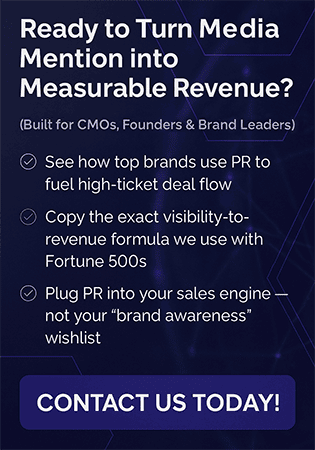There’s an intense push-and-pull going on in B2B marketing right now.
On the one hand, marketers are being pushed toward measurement and metrics. Analytics have become a part of nearly every marketing conversation—sometimes for better, sometimes for worse.
On the other hand, the B2B customer journey has grown more messy, complex, and difficult to track. A major reason for this is that a growing number of purchasing decisions are being made and discussed on dark social—in other words, the private LinkedIn messages, Slack channels, and closed online communities marketers can’t see.
Touchpoints are happening all the time in these closed channels, but brands have no way of measuring them. So, given that a lot of the customer journey has become unmeasurable, how should B2B brands proceed?
The answer (at least, part of the answer) is to focus on three things: increasing your share of voice, using the tools you do have at your disposal to make the most of dark social, and tracking the right metrics.
Let’s take a closer look.
What Is Dark Social?
Coined by Alexis Madrigal, dark social refers to the “invisible” shares between consumers that happens behind the scenes. Rather than messages being shared on social platforms such Instagram, Facebook, or X, shares are happening through channels like messengers and texts. That being said, the content being shared behind the scenes isn’t being tracked by web analytics tools. Why is this important for your brand? Let’s find out.
Related reading: 30 Common Questions About Social Media Marketing Answered
Dark Social Examples
Now that you’re familiar with the definition of dark social, here’s a list of dark social channels to give you a better idea of what to watch out for:
- WhatsApp – A messaging app that allows users to send text messages, voice messages, photos, and videos to other users.
- Facebook Messenger – A messaging app that allows Facebook users to send and receive messages, photos, and videos.
- Email – A traditional method of communication that allows users to send messages and files to other users.
- SMS – A text messaging service that allows users to send messages to other users’ mobile devices.
- Slack – A messaging app primarily used for team communication in a work setting.
- Discord – A voice and text platform that allows users to send messages, photos, videos, and files, and also offers group chats and channels.
- WeChat – A messaging app that is popular in China and offers messaging, voice calls, and video calls, as well as additional features like payment processing and social networking.
Why Is Dark Social Important?
Dark social is important for brands because it accounts for a significant portion of web traffic. By not tracking this traffic, your brand is missing out on valuable insights into what content is being shared and what channels are most effective in driving conversions for your business. If your brand wants to optimize your social media marketing strategy and, ultimately, increase ROI, understanding and tracking dark social is crucial.
1. Dark social is everywhere
Whether you like it or not, dark social is here to stay and its impact is only growing. While there’s no way to measure exactly what percentage of social shares come from dark social, a recent study by SparkToro calculated dark traffic on major social networks. The research found 100% of all visits from TikTok, Slack, Discord, Mastodon, and WhatsApp were marked as “direct” while 75% of visits from Facebook Messenger were missing referral information, as well as 30% of Instagram messages (DMs), 14% of public LinkedIn posts, and 12% of public Pinterest posts.
2. Dark social is an unseen marketing opportunity
Dark social is an opportunity for B2B brands to see what their potential customers are really like. What are their interests and top concerns? This is an opportunity for your brand to get familiar with your target market and tweak your strategy to truly speak to them, opening your brand up to a whole possibility of new connections.
What Is Share of Voice and Why Does It Matter?
Share of voice is the percentage of conversation your brand owns in the market. It can also refer to the amount of advertising your brand has compared to the total amount of advertising in your industry, rendered as a percentage.
Think of this in terms of a major brand, like Kleenex. If you were a B2B buyer in charge of purchasing paper products for all your brand’s offices, Kleenex is probably the first brand that would come to mind. That’s because their advertising is everywhere, so their share of voice overshadows that of their competitors.
That doesn’t mean you would undoubtedly choose to purchase with Kleenex—it would be dependent on other things like pricing, timeline, etc.—but Kleenex would certainly be present in your mind throughout your decision process, and likely for any and all future paper product purchasing decisions you had to make for your brand.
Brands that have a huge share of voice also have an ongoing presence in buyers’ minds. Think of your brain as a phone: the brands with a huge share of voice are like those apps running in the background, always on, and always easy to access.
Increasing your share of voice requires regularly putting out great content, implementing PR campaigns to boost your reputation and backlinks, creating paid ads to bring people to your best content, and participating in thought leadership opportunities as much as possible.
Related reading: Build a Successful B2B PR Strategy in 2024
As your share of voice goes up, you’ll reap a number of benefits, including:
- A boost in reputation and brand trust
- SEO improvements, including an increase in the number of backlinks your brand has
- A larger share of your market
How Does Share of Voice Impact Dark Social?
You may not be able to accurately measure dark social traffic or determine just how many people are talking about your brand on a given day, but you can determine how much space you take up in your market. The more space you take up, the more likely it is that customers will be talking about you, whether you’re aware of those conversations or not.
If you think about it, what’s happening now isn’t much different from marketing and advertising in the pre-internet days.
When brands made a TV commercial or bought a print ad in a publication, there was no way to tell if potential customers were talking about the ad at work or with their friends or colleagues. Today, we have more information at our fingertips, which is partly why not knowing feels so difficult for marketers. We’ve gotten used to being able to track every interaction, mention, and engagement.
But while much of dark social will always remain in the dark, there are certain tools you can use to glean some information.
How to Make the Most of Dark Social Sharing
Now that we’ve established how critical share of voice is to succeeding in the B2B space, let’s look at how you can make the most of all the dark social sharing and discussions that are happening around your brand. After all, it’s growth in your share of voice that will impact the number of dark social mentions and amount of activity your brand experiences (even though you won’t be able to see it).
As the term “dark social” implies, these are conversations we simply can’t track. Think in-person conversations, social posts in private groups or locked accounts, shares sent via direct messaging, and more. The good news is there are certain things you can do have a little more insight:
- Use link shorteners, like bit.ly, because these allow you to track those links across the internet.
- Emphasize your social sharing buttons by making them easy to find on your website and each piece of owned content (blog posts, articles, etc.). Sharing via these buttons is trackable, so you want to make it as easy as possible to do so.
- Add UTM codes to specific links you want to track. These codes make it easier for Google to track those links.
- Use dark social platforms or tracking tools, like GetSocial or Radarr.
You may not be able to track all the dark social content surrounding your brand, but you can narrow in on more insights with the right tools.
5 Ways Marketers Can Leverage Dark Social Sharing
In 2025, a crop of new platforms and technologies have emerged to fill these gaps, altering dark social itself at a rapid pace. Brands must stay informed about these developments, integrating emerging platforms into their marketing strategies and removing tools that no longer work. With advancements in AI and machine learning (ML) just starting to infiltrate our marketing and social media strategies, there are even more opportunities to glean insights from these private interactions while respecting privacy norms and regulations.
Referral Marketing
Offer referral programs where customers can refer their friends and family to your company’s products or services. These referrals often happen through private channels such as email or messaging apps, and can be difficult to track, but UTM links can help.
Closed Online Communities
Businesses might create closed online communities, such as Facebook groups or Slack channels, for their customers and fans to connect and share information. These communities can be a great way for companies to engage with their customers and help to monitor information sharing.
Influencer Marketing
B2B companies often rely on recommendations and word-of-mouth referrals to gain new clients. These referrals usually happen through private channels such as email or messaging apps. On the other hand, B2B companies also work with influencers to promote their products or services. Influencers may share information about a product or service to their followers through private channels such as direct messages, paid subscription platforms, or newsletters. Be sure they share this content with your team and include UTM links.
Share Buttons
Including share buttons is a common way for companies to encourage users to share their content via dark social channels. By including share buttons in your content, B2B companies can make it easy for users to share the content with others, which can increase the reach of the content and make it more visible to a larger audience. For example, if a user enjoys reading an article on your company’s blog, they may want to share it with a friend who might also be interested. If there are share buttons available, the user can simply click the button and select the platform or app they want to use to share that content.
Offer exclusive deals
B2B companies can offer exclusive deals or promotions that are only available to those who share via private messaging apps. This can incentivize users to share content via dark social channels and help increase the reach of your content.
Track the Metrics That Matter, Not Just the Ones That Are Easy
Too many analytics might not be a good thing. In fact, they can make it difficult to discern which metrics really matter, and which are simply…trackable.
As our CEO and founder Shama Hyder says, “Just because something is measurable and efficient doesn’t mean it’s meaningful and effective.”
A perfect example? Click-through rate (CTR). A high click-through rate doesn’t necessarily indicate a high level of meaningful engagement, but it is incredibly easy to measure, and a high CTR can make a campaign look good when presented strategically.
But there are many other, less obvious metrics that mean a lot more when looked at as part of an entire picture. For example, you could track your growth in share of voice over time and see whether that matches up to an increase in newsletter sign-ups or demo requests.
You can also track social media engagements in relation to specific PR campaigns or product launches. Better yet, you can look at all these numbers and put them together to create a larger picture of how your brand is doing in the marketplace.
When it comes to tracking dark social, remember these key points:
- Dark social happens in Slack channels, Microsoft teams, emails, LinkedIn DMs, etc.
- Dark social is how consumers are communicating, how prospects are buying—and that’s not changing anytime soon, it’s just going to continue to grow
- You can try to influence what’s happening in dark social, but you can’t control it and you can’t comprehensively track it
- Instead, focus on creating content that people want to talk about and is valuable
- Questions to ask your customers if you really need some form of quantitative data:
- What do you consume?
- How did you find out about us?
- Who are your peers?
Dark Social Tracking
Finally, to boost both your “regular” and dark social engagement, get better at anticipating what your prospects and customers want from you. When going through the buying journey, your prospects need access to specific information at any given time, and it’s up to your marketing team to anticipate those needs.
Last year we saw advancements in tracking technologies, specifically regarding AI and ML. Brands can now leverage sophisticated tools and methods, like predictive analytics, to better understand and anticipate trends in dark social. Start by conducting a content audit, asking: Where are your content offerings lacking? Do you have lots of content for the top of the funnel, but hardly any for the bottom? Are you targeting a couple of personas with your blog posts, but overlooking others?
A thorough B2B content audit can give you a good indication of where you are right now, which will help you decide where you need to improve. Consider which questions your customers and prospects frequently ask your sales team and learn their pain points. This is information you need to know if you’re going to give them content that converts.
The most reliable way to do this is to directly ask your prospects and customers through surveys, social media polls, or on sales calls (the data you get this way is called zero-party data).
Dark Social Examples
Still not sure what dark social looks like? We’ve collected a few examples below:
Cookie Tracking
Dark Social refers to websites that use methods other than cookies to track users across different channels such as email, mobile apps, etc. These sites often use tracking pixels, clear GIFs, and JavaScript code to monitor user behavior without storing data locally on their computers.
For example, when someone visits a website via an app, they may be prompted to install another app onto their device. The new app might then send information back to the original site about which features were used within the app.
Product Tracking
Another example would be a company building a product that sends emails directly to customers who haven’t opted into receiving them. They could do this by sending a link to download the software to anyone who opens the email. When the customer downloads the software, the company will know exactly where the person came from (email address) and what they did after opening the email (download the software).
Sharing URL Links
A user may come across an interesting article on a website and want to share it with a colleague or friends. Instead of posting the link on their public profile, they send it through a direct message, making it difficult for the website owner to track the source of referral traffic.
Emailing
A user may come across a video on a website and think a friend would find it interesting. They may choose to email the link to their friend, rather than sharing it publicly on social media. The website owner cannot see or track this interaction.
Forums and Group Chats
A user may come across a website and want to share it with a specific group of people. They may do this by posting the link in a closed forum or chat group that is not visible to the public. Unless the website owner is part of this group, they have no way of tracking the source of the referral traffic.
Mobile Messaging
A user may come across a website and want to share it with a specific group of people. They may do this by sending the link through a mobile messaging app like WhatsApp or Signal, which are not publicly accessible. This makes it difficult for the website owner to track the source of referral traffic.
Virtual Word of Mouth
A user may come across a website and want to share it with a specific group of people during a meeting. They may do this by copying and pasting the link into a virtual meeting or video call, which is not publicly accessible.
QR Codes
A user may come across a website and want to share it with a specific group of people. They may generate a QR code that links to the website, and share it through a print or digital medium, making it difficult for the website owner to track the source of referral traffic.
All of these types of shares are called “dark” because they’re not visible to users unless they take special steps to look for it. It’s important to note that while these types of tracking tactics are common, most companies don’t actually need access to personal information like browsing histories or even IP addresses.
The Truth About Dark Social Analytics
When website owners and marketers access their analytics tools to gain insights into how visitors find their websites, they rely on analytics software to identify the known source of referral traffic. However the majority of referral data from dark social traffic comes with significant flaws. Many big social networks like to hide where their traffic comes from, and some even keep the referral data under wraps.
Remember the SparkToro study we mentioned above? This information suggests website owners and marketers should anticipate that a significant portion of traffic labeled with a “direct” referral tag likely comes from instant messaging and private sharing links on these platforms. Dark social media is a real and ongoing phenomenon that can cause problems for those who solely rely on analytics data to understand where their traffic is coming from.
Your Marketing Strategy Can’t Ignore Dark Social
Effective marketing in 2025 requires the integration of dark social strategies with broader digital marketing efforts. This means ensuring your content marketing, REO and SEO, and influencer partnerships take on a cohesive approach to engaging audiences across all channels.
Your goal should always be to create something valuable enough for your customers that they want to share it in their private channels! Dark social is intricately related to your share of voice, and it’s where a lot of the B2B buyer journey is happening. By creating great content, increasing your share of voice, and focusing on the right metrics, you’ll be able to turn dark social into a valuable tool rather than a frustrating unknown. Ready to shine a light on your dark social strategy? Reach out!





